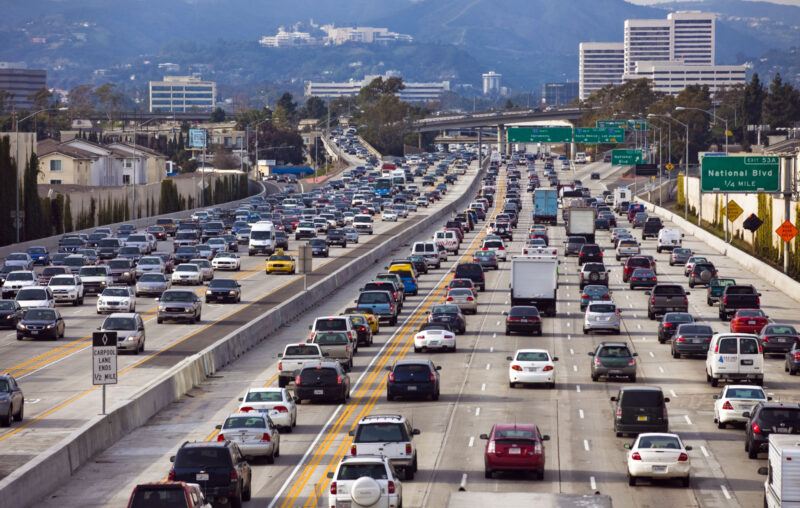

Reprinted from the Cato Institute
One of the least enjoyable aspects of working is the process of actually getting to work. For nearly 85 percent of Americans, that means driving a car, truck, or some other vehicle an average of 27.6 minutes each way. That compares to an average of 25 minutes in the European Union and represents nearly an hour of each day that is mostly wasted. Millions more Americans, meanwhile, are stuck using mass transit systems that are unnecessarily costly, slow (average one‐way bus commute time: 46.6 minutes), or unreliable. The country can do better. As I explain in the new Cato Institute book Empowering the New American Worker: Market‐based Solutions for Today’s Workforce, while commuting may be an unfortunate reality of working life, changes to public policy—including trade policy—can help ease this burden for American workers.
The pain of commuting begins with obtaining the means to get to work—some kind of vehicle for most people—and that’s not cheap. The average price of a new subcompact car currently runs over $23,000 and things only get more expensive from there. Such prices are partly due to tariffs on autos and auto parts. Although typically modest at 2.5 percent, such duties can spike as high as 25 percent for light trucks—the infamous “chicken tax”. Tariffs on inputs such as steel and aluminum also exert upward pressure while imported tires from several Asian countries are subject to duties that can reach over 100 percent.
Other government policies further drive up costs. CAFE standards meant to improve gas mileage require automakers to make costly capital investments that are passed along to consumers. Laws that prohibit auto manufacturers from selling directly to consumers and impose other restrictions to spare dealerships from competition are found in most states. Jones Act shipping restrictions and the Renewable Fuel Standard increase the cost of gas. Occupational licensing laws and immigration restrictions reduce the supply of mechanics and increase auto maintenance costs.
It all adds up.
Americans pay in less direct ways as well, such as time spent in traffic and driving long distances to their places of employment. One reason for long commutes is zoning policies and related restrictions on land development that limit the amount of housing that can be built. Such laws drive up prices, push development outwards, and separate workers from their places of employment. Many Americans don’t live closer to their places of employment because they simply can’t afford to.
Beyond sheer distance, commutes are lengthened by infrastructure that is either inadequate or overconsumed due to a lack of pricing. While initiatives such as dynamic tolling can help with the latter, a lack of infrastructure can be partly traced to misguided government policies. Buy America laws, for example, require the use of U.S. inputs in infrastructure projects such as iron, steel, and other construction materials. That makes sourcing the materials for infrastructure projects both more costly and time‐consuming. Environmental impact statements required by the National Environmental Policy Act and Davis‐Bacon Act mandates that “prevailing wages” be paid on infrastructure projects contribute to both delays and increased costs.
Such restrictions and added red tape have obvious implications for the users of mass transit as well. Indeed, mass transit is burdened by protectionism not only in the construction of infrastructure but the acquisition of needed capital equipment as well. Rolling stock such as light rail and buses acquired with federal public transportation funding are required to have at least 70 percent of their cost manufactured domestically and final assembly taking place in the United States. These requirements increase costs and make the modernization and expansion of mass transit system a more difficult and expensive proposition.
Workers that commute by ferry, meanwhile, are subject to even more onerous protectionism. The Jones Act and Passenger Vessel Services Act require vessels transporting people and goods (such as car ferries) within the United States to be U.S.-built. That adds significant costs to the purchase of new ferries and helps explain the continued use of vessels long past their prime (the Cross Sound Ferry between Long Island and Connecticut, for example, uses a vessel that saw service during World War II).
Commuting is never going to be the highlight of the day for most people. But policy changes can make it a less costly, faster, and overall less aggravating experience. Some of these, such as repealing protectionist measures that increase the cost of building, acquiring, and maintaining infrastructure and capital equipment are obvious steps. But removing sand from the country’s collective transportation gears will also require more imaginative solutions such as congestion pricing, privatization, zoning reforms, and transportation options beyond cars.
For a more in‐depth discussion of this topic (transportation chapter here) and plenty of other ways that expanded economic freedom can help improve the lives of U.S. workers, please check out Empowering the New American Worker: Market‐based Solutions for Today’s Workforce.
TELL YOUR FRIENDS ABOUT CITIZENS JOURNAL Help keep us publishing –PLEASE DONATE





